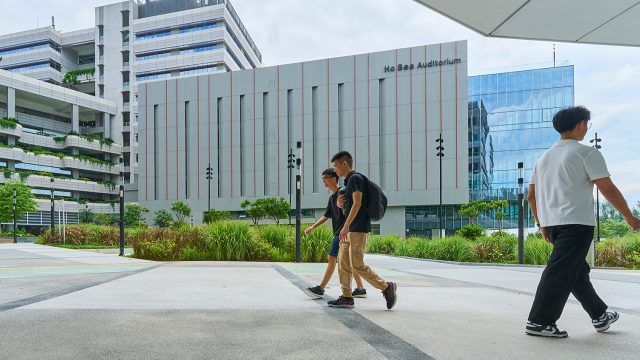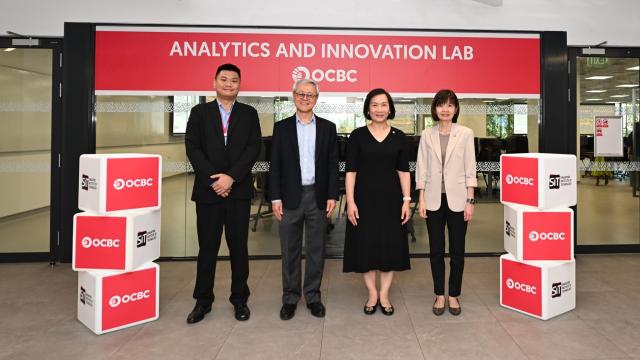
Giving their thumbs-up to the Punggol Digital District (L to R): Mr Tan Kiat How, Chief Executive Officer, Info-communications Media Development Authority Commissioner, Personal Data Protection Commission; Mr Lim Eng Hwee, Chief Executive Office, Urban Redevelopment Authority; Dr Janil Puthucheary, Senior Minister of State, Ministry of Education & Ministry of Communications and Infomation; Dr Yaacob Ibrahim, Minister for Communications & Information, the Minister-in-charge of Muslim Affairs and the Minister-in-charge of Cyber Security; Mr Teo Chee Hean, Deputy Prime Minister, Coordinating Minister for National Security and Minister-in-charge of the Civil Service; Mr Lawrence Wong, Minister for National Development and Second Minister for Finance; Ms Sun Xueling, Member of Parliament, Pasir Ris-Punggol GRC; Mr Ng Lang, Chief Executive Officer, JTC and Professor Tan Thiam Soon, President, Singapore Institute of Technology
21 January 2018 - The Infocomm Media Development Authority (IMDA), JTC, Singapore Institute of Technology (SIT) and Urban Redevelopment Authority (URA) jointly unveiled the masterplan for the Punggol Digital District1 (PDD) today. Deputy Prime Minister and Coordinating Minister for National Security Teo Chee Hean launched an exhibition showcasing the masterplan at Waterway Point, and invited the community to be part of the exciting possibilities of a district driven by technology and innovation
The First District Integrating Business and Education, Driven by Technological, Social and Urban Innovation
Punggol Digital District is planned as part of Singapore’s strategy to sustain long-term economic growth by creating new development areas island-wide, and bringing good jobs and social amenities closer to residents. URA’s Chief Executive Officer, Mr Lim Eng Hwee, said, “Our plan is to capitalise on future trends and the key assets in each area to develop highly integrated and inclusive spaces to live, work, play and learn. Each district will have a unique role in contributing to Singapore’s growth in the future economy, and be defined by a distinctive identity and environment. PDD will anchor the north-east region, and be the key in driving our competitiveness in this age of the digital economy.”

Situated in Punggol North, PDD is envisioned to be a vibrant and inclusive district underpinned by cutting-edge technology, as well as urban and social innovation which make everyday living more convenient and sustainable. As Singapore’s first Enterprise District, PDD will provide flexibility for the land use mix and scale to be curated at district-level, enabling deeper integration and synergy of different uses and spaces to realise the vision of the District. The District is also planned to be connected to the greater Punggol area, with a car-lite, green, and vibrant environment.
JTC’s Chief Executive Officer, Mr Ng Lang, said, “To be developed progressively, Punggol Digital District will be the first district to adopt a one integrated masterplan approach that brings together a business park, a university and community facilities. Such a district-level planning approach creates synergies, optimises land use and catalyses community building. It also allows us to design and integrate technological and innovative platforms and services right from the start and from the ground up, potentially transforming the way we work, live, learn and play in an inclusive and sustainable district.”
A Home for Key Growth Industries of the Digital Economy
Scheduled to commence development this year, JTC’s business park buildings will house key growth sectors of the digital economy, such as cyber security and Internet of Things (IoT), which will in turn drive the wider transformation efforts for the Singapore economy. Locating these sectors in the District will bring approximately 28,000 jobs closer to residents in Punggol and the north-east region.
“PDD is a good example of the digital transformation we aspire to create, anchored by technology, innovation and collaboration. IMDA is bullish about the growth of frontier technologies, such as cyber security and IoT, as these sectors will power the digitalisation of our economy. By clustering these growth sectors, we aim to create an ecosystem of collaboration and innovation that enables our businesses and people to thrive in a digital economy. As a greenfield site, PDD has the flexibility to incorporate industry needs into the core of its design and allows for an unprecedented level of integration between industry and academia,” said Angeline Poh, Assistant Chief Executive (Industry Development), IMDA.
The Future of Learning through Collaboration and Community
PDD will be home to SIT’s new campus. This co-location with JTC’s business park buildings will facilitate the cross-fertilisation of knowledge and collaboration opportunities among students, faculty and industry professionals. As an Enterprise District, different land uses can be co-located within a development. SIT’s research labs and learning facilities could reside within JTC’s business park buildings. Similarly, JTC could host industry research, development facilities and even create startup spaces within SIT’s campus. This “exchange” of space creates greater synergies between academia and businesses to create, test-bed and prototype new ideas and innovations.
“At SIT, such collaborations enable our students to stay competitive amid fast-evolving skill sets required by industry. Our applied learning pedagogy and close industry relations, enhance the curricula of our degree programmes with a strong industry focus to meet future manpower and industry demands. SIT students will especially benefit through these partnerships, by leveraging the expertise of industry through ‘industry teaching laboratories’. This will allow SIT to pilot programmes to support research work and learning. Ultimately, the PDD presents a golden opportunity for us to showcase the benefits of close industry-academia partnerships where SIT students could be groomed to seamlessly transition into their chosen careers,” said Professor Tan Thiam Soon, President, SIT.
JTC will also have the flexibility to curate the tenant mix to achieve a more complete and integrated system to meet the demands of the digital economy. New technological or business ideas conceived in SIT could be tested and adopted by businesses in PDD, contributing to a higher rate of commercialisation success. Similarly, innovative enterprises affiliated with SIT’s strengths in applied programmes such as cyber security, electrical power engineering, food technology (R&D), design, assistive technology and hospitality can tap on SIT’s research capabilities for R&D and student pool for talent.
SIT is also seeking to empower the Punggol community with a MakerSpace that will bring the learning-by-doing experience to Punggol residents. Residents can tinker with ideas and even prototype new solutions within the MakerSpace, applying their knowledge to solve issues within their homes and environment.
A New Standard for Sustainability and Liveability
A suite of innovative district-level infrastructure and technologies will optimise the use of land, as well as energy and resources to enhance liveability and reduce carbon footprint. They include an integrated Facilities Management System for optimal building management, a Pneumatic Waste Conveyancing System for automated waste collection, Urban Logistics for centralised automated delivery of goods, and IoT systems from the ground up that allows continuous digital experimentation and innovation. Where possible, these infrastructure will be sited underground.
The District will also see the deployment of IoT and sensor technologies to enhance community living, supporting the work of the Government Technology Agency (GovTech) on the Smart Nation Sensor Platform. These could include environmental sensors to monitor air quality and noise, and cameras to detect, classify and count Personal Mobility Devices (PMDs) in public spaces such as cycling paths, pedestrian walkways and roads. JTC is currently partnering GovTech to trial these technologies.
The range of innovative technologies that will be test-bedded and piloted in PDD is also aligned with the plans for surrounding residential areas, such as HDB’s latest district, Punggol Northshore. “A Smart & Sustainable District”, Punggol Northshore will have digital infrastructure provided in flats to pave the way for smart-enabled homes, which allow residents to tap on smart home applications developed by commercial companies with greater ease.
An inclusive district that is Vibrant, Car-Lite and Green
Punggol Digital District will not only be about technology and infrastructure, but an inclusive and green district for the community. It will be seamlessly integrated with the surrounding residential areas and include green links to the waterfront. The existing Punggol Road will be pedestrianised and transformed into a Heritage Trail linking Punggol Waterway Park to the Punggol Promenade Park Connector. The trail will also connect Punggol Waterway, PDD and the upcoming residential district at Punggol Point.
The community can relax, recharge and recreate in vibrant public spaces amid retail, dining and leisure options. This includes a Campus Boulevard at the heart of the District that connects people to key developments, amenities and green and blue spaces such as the waterfront and Coney Island. The Punggol community can also look forward to new amenities such as a naturally ventilated Hawker Centre with e-payment technology and Automated Tray Return System; a community club to serve recreational needs; and childcare centres located near the Heritage Trail where children can explore outdoor gardens.
PDD will take Singapore’s car-lite movement even further with its comprehensive network of infrastructure and facilities to support greener mobility options. The community can look forward to commuting by foot, cycling, PMDs, and even Autonomous Vehicles (AVs). The District is also planned to be commuter-centric, and will be conveniently accessible by public transport, with the future Punggol Coast MRT Station and a new bus interchange.
About The Infocomm Media Development Authority
The Infocomm Media Development Authority (IMDA) leads Singapore’s digital transformation with infocomm media. To do this, IMDA will develop a dynamic digital economy and a cohesive digital society, driven by an exceptional infocomm media (ICM) ecosystem – by developing talent, strengthening business capabilities, and enhancing Singapore's ICM infrastructure. IMDA also regulates the telecommunications and media sectors to safeguard consumer interests while fostering a pro-business environment, and enhances Singapore’s data protection regime through the Personal Data Protection Commission.
For more news and information, visit www.imda.gov.sg or follow IMDA on Facebook IMDAsg and Twitter @IMDAsg.
About JTC
Set up in 1968, JTC is the lead government agency responsible for the development of industrial infrastructure to support and catalyse the growth of industries and enterprises in Singapore. Landmark projects by JTC include the Jurong Industrial Estate; the Jurong Island for energy and chemical industries; business and specialised parks such as Airport Logistics Park of Singapore, International Business Park, Changi Business Park, Seletar Aerospace Park, CleanTech Park and Tuas Biomedical Park; a new work-live-play-&-learn development called one-north; and the Jurong Rock Caverns, Southeast Asia’s first commercial underground storage facility for liquid hydrocarbons. JTC also develops innovative space such as JTC Surface Engineering Hub, JTC MedTech Hub @ MedTech Park and JTC Food Hub @ Senoko, which incorporate innovative features and shared infrastructure to enable industrialists to start their operations quickly and enhance productivity.
For more information on JTC and its products and services, please visit www.jtc.gov.sg.
About Singapore Institute of Technology
Singapore Institute of Technology (SIT) is Singapore’s university of applied learning. It aims to be a leader in innovative university education by integrating learning, industry and community as part of its unique pedagogy. Partnering world-class universities, SIT offers applied degree programmes targeted at growth sectors of the economy. SIT also aims to cultivate in its students four distinctive traits, or the SIT-DNA, which will prepare them to be ‘thinking tinkerers’, who are ‘able to learn, unlearn and relearn’, be ‘catalysts for transformation’ and finally, become ‘grounded in the community’.
For more information, visit www.SingaporeTech.edu.sg.
About Urban Redevelopment Authority
The Urban Redevelopment Authority (URA) is Singapore’s land use planning and conservation agency. Our mission is “to make Singapore a great city to live, work and play”. We strive to create an endearing home and a vibrant future city through far-sighted planning and innovation, in partnership with the community.
We have successfully transformed Singapore into one of the most liveable cities in Asia through judicious land use planning and good urban design. Adopting a long-term and comprehensive planning approach, we formulate strategic plans such as the Concept Plan and the Master Plan to guide the physical development of Singapore in a sustainable manner. Our plans and policies focus on achieving a balance between economic growth and a quality living environment.
To turn plans and visions into reality, we take on a multi-faceted role. In addition to our planning function, we are also the main government land sales agent. Through the sale of State land, we attract and channel private capital investment to develop sites to support economic and social development. As the conservation authority, we have an internationally recognised conservation programme, and have successfully conserved not just single buildings, but entire districts. We also partner the community to enliven our public spaces to create a car-lite, people-friendly and liveable city for all to enjoy.
In shaping a distinctive city, we promote architecture and urban design excellence, and innovate to build a resilient city of opportunity that fulfils and anticipates the aspirations of our people.
Visit www.ura.gov.sg for more information.


![[FA] SIT One SITizen Alumni Initiative_Web banner_1244px x 688px.jpg](/sites/default/files/2024-12/%5BFA%5D%20%20SIT%20One%20SITizen%20Alumni%20Initiative_Web%20banner_1244px%20x%20688px.jpg)


